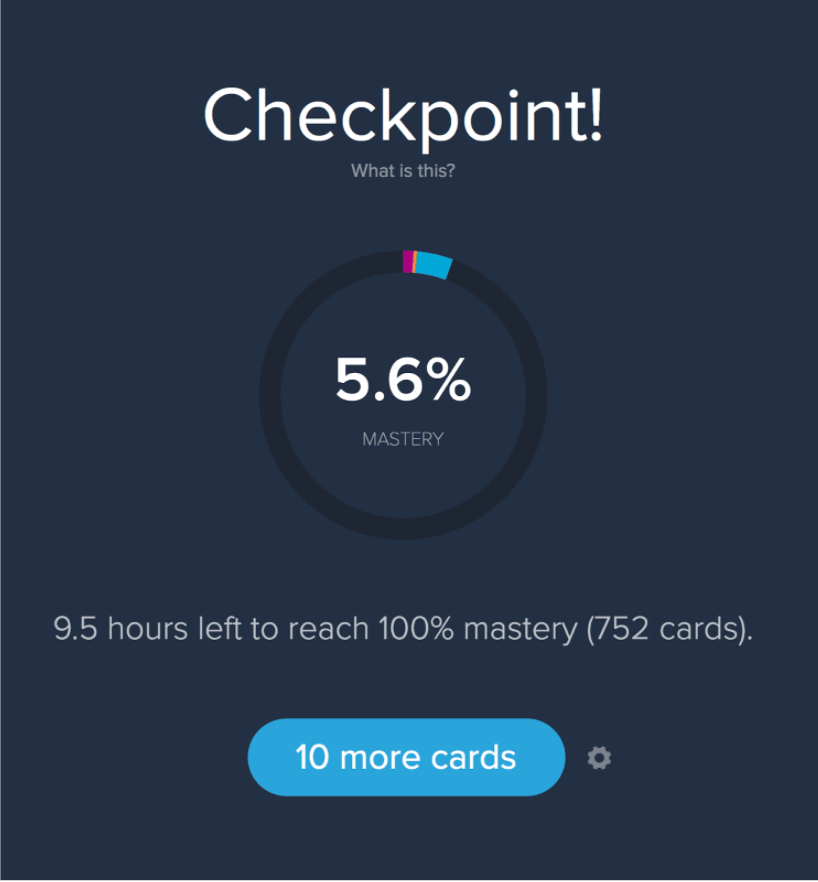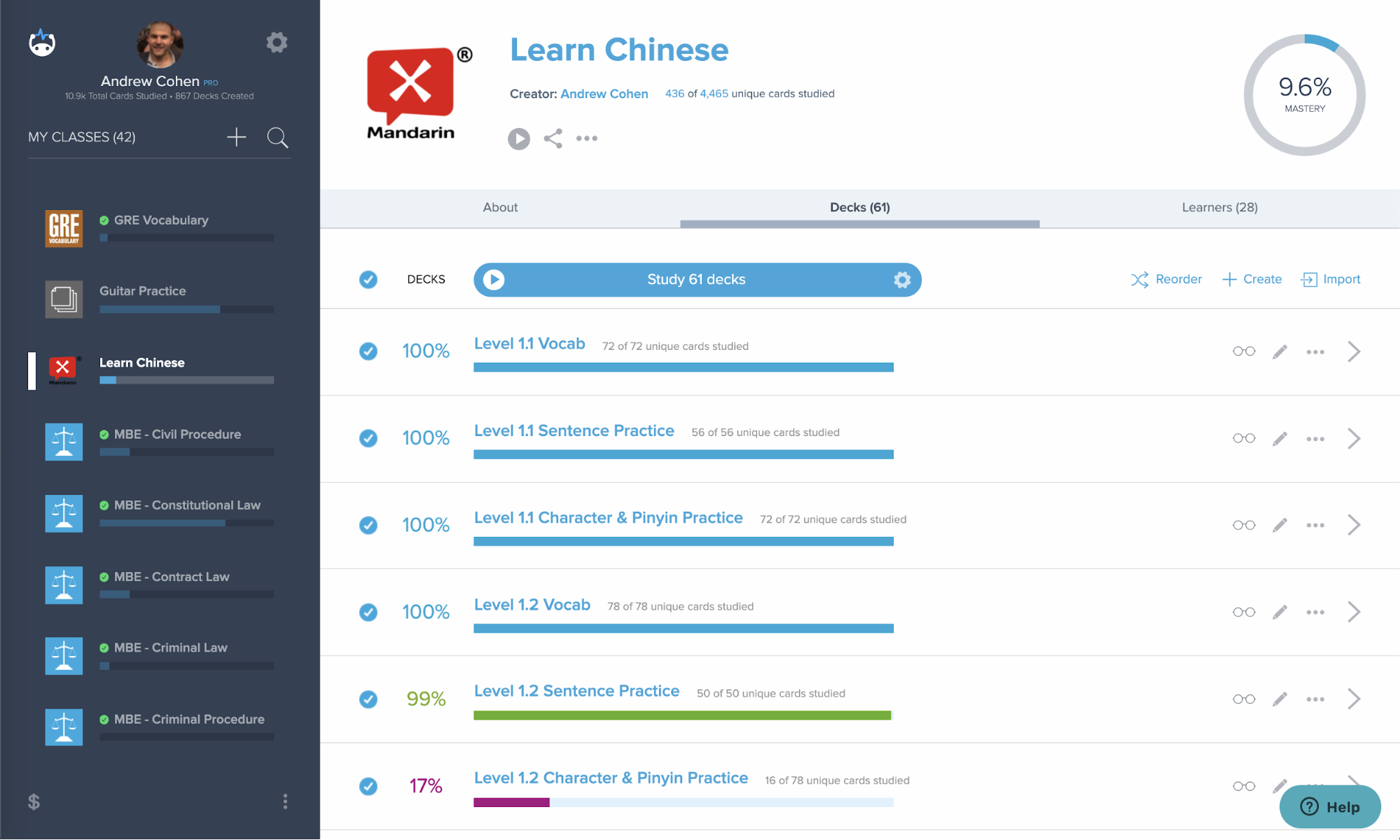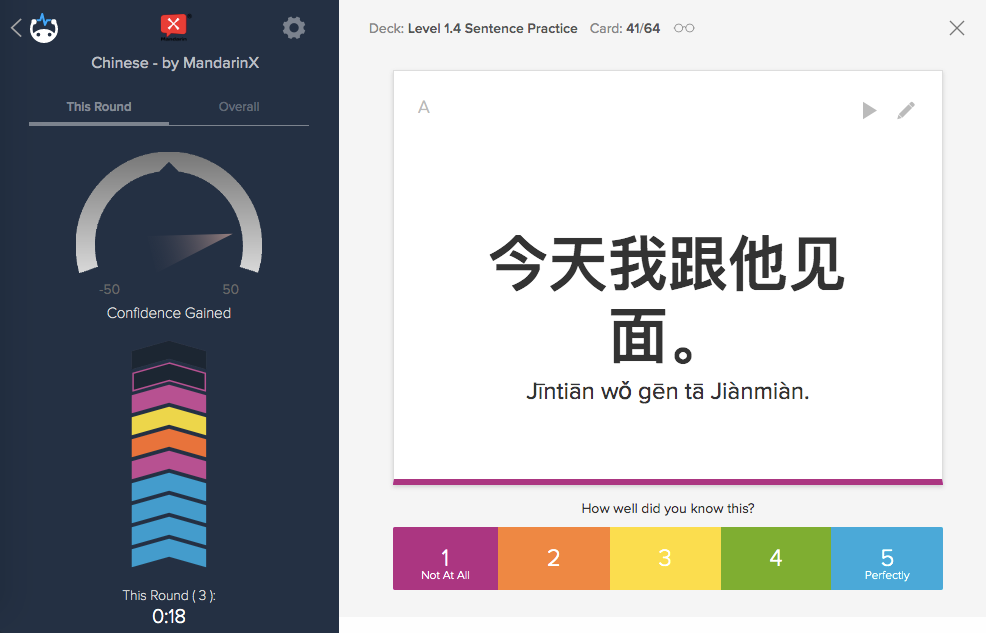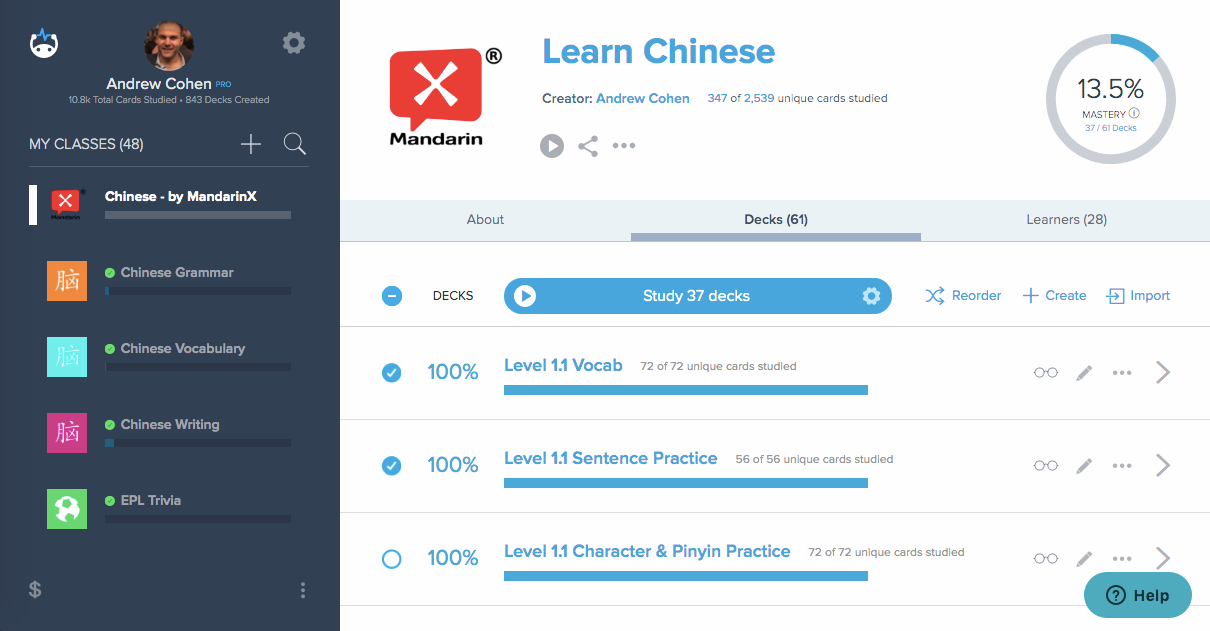Whether for travel, business, inclusion, culture, or just plain curiosity, there is a staggering diversity of good reasons to learn Mandarin Chinese.
Mandarin is the most widely spoken language in the world and with the country at the leading edge of global commerce and trade, learning it can open innumerable professional doors for you. China also has a long, significant history and a rich, colorful culture that can be easily accessed through its language, which is a huge benefit if you are an insatiable traveler or want to move to China to teach English.
So, from fluently ordering your favorite dishes off the menu and chatting with the locals in the beautiful Guilin countryside to brokering a new deal with your Chinese business partners, learning Mandarin can enrich your life and boost your career prospects.
And it’s NOT as hard as so many people think!
In this article, we’ll give you a step-by-step guide to learning Mandarin Chinese more efficiently, using Brainscape’s adaptive web and mobile Mandarin Chinese flashcard course as the heart of your curriculum. We’ll also tell you how to supplement your learning with some of the best resources on the Internet. Here's the overview:
- How to stay motivated to learn and use Chinese
- The importance of repetitive drilling
- Step-by-step guide to learning Chinese more efficiently
- You CAN learn Chinese
First, though, let’s look at where most learners get snagged so that you are mentally prepared to face down (and overcome) the challenges the language presents.
The trick to learning Chinese...

The most confronting difference between Chinese and the languages you are probably more familiar with—like English, Spanish, and French—is that it’s written in symbols, pictograms, and semi-phonetic ideograms rather than alphabetic letters. And where the Latin alphabet is designed to sound out the words we spell, in Chinese, every symbol, depending on how it is written, has a unique meaning.
Just like there are thousands and thousands of words (but made up of only 24 letters), so too are there thousands and thousands of symbols. But where “Western” words are composed of only 24 possible letters, Chinese symbols all look different. And so the prospect of learning them can be intimidating.
Make peace with that now. It’s intimidating, yes, but you don’t have to learn them all at once. We’ll show you exactly how you can munch your way through, symbol by symbol.
Once you see past this initial hurdle, Chinese is quite easy to learn! (Check out these top Chinese language learning apps to get started!)
It’s certainly much less challenging than English. Its grammar is very straightforward and there are no genders, tenses, or cases to learn. And while, yes, there are tones in Mandarin Chinese that you have to learn, even these aren’t that hard once you get into the rhythm of things.
Learning Chinese is a challenge, like any language, but it’s also very doable. Tens of thousands of people from all over the planet sit down to their textbooks to learn Mandarin Chinese every day.
SO CAN YOU! And, with a little guidance, you can do it more efficiently too. That’s what this guide is for.
Are you ready? Are you excited?
我们走吧! (Let’s go!)
1. How to stay motivated to learn and use Chinese

Learning any language requires a dogged, daily devotion of time and if you aren’t committed, you’ll soon find yourself straying from the path. So, here are two important things you need to know before you embark on your Chinese language learning journey:
- You need to stay motivated, and
- You need to use the language right from the start.
1.1. Staying Motivated
To really learn a language, you need to be serious, devoted, and consistent in your approach to mastering it. This is not an endeavor of a few weeks: it’s a habit you’ll need to develop for several months, if not years.
This means that long-term motivation is key. Motivation is what’s going to carry you out the other side of the initial enthusiasm and motor you through the rough patches, where the mental slog wears you down.
Here are three ways you can stay motivated to learn Mandarin Chinese:
Focus on connection
Languages are used to communicate with people. Focus on how learning Chinese will help you connect with your friends, family, community, or business partners. Visualizing yourself chatting freely in Mandarin with a client or your parents-in-law and this will be a huge boost to your motivation.
Decide on your goal proficiency
Like any language, it takes a long time to become fluent. But think of the 80-20 rule: you don’t need to be good at Mandarin, you just have to be good enough to achieve your desired outcome, whether that’s to hold your own in a business conversation or chat to your English class about their weekends. Take the pressure off yourself to be perfect, focus only on your goal, and you’ll find it far easier to feel motivated.
Set a timeline
Yep, you need deadlines. Deadlines provide measurable milestones for success. They also breathe down your neck, reminding you to get a job done. So, break your learning journey into a swarm of smaller, manageable goals and put a timeline in place.
Pro Tip: Brainscape’s language-learning flashcards actually provide an estimation of how much time is needed to master a deck. Use that to calibrate your studies and stay on track with your timeline.

1.2. Use the language right from the beginning
Mandarin Chinese is a tonal language. This means that the vocal tones you use when pronouncing words (whether high, low or transitioning from one to the other) influences their meanings. Two words might sound exactly the same when spoken, but expressed in different tones, they can have two completely different meanings.
So it’s really important that you dedicate time and practice to getting tonal pronunciations right.
This isn’t something you can do “later on”. The best way to master the tonality of Chinese Mandarin is to start from the get-go, from day one. It’ll feel weird at first: kind of like you’re singing the words rather than saying them. Work with a tutor or language partner right from the beginning so that they can help you get it right. Pretty soon, those tonal acrobatics will feel organic.
Pro Tip: If you’re looking for an excellent, qualified Chinese tutor, try Mandarin X, the author of Brainscape’s Chinese curriculum, who offers some of the best online tutors available anywhere.
With these special messages out of the way, let’s dive into how Brainscape uses key cognitive science principles to help you learn Chinese Mandarin more efficiently!
2. The importance of repetitive drilling
Because there’s nothing to compare Chinese characters and tones to in the Latin alphabet, mastering them essentially requires sheer memorization. You just have to study and practice them over and over again, until their shapes and sounds become stitched into the right hemisphere of your brain.
Forget whimsical language-learning games and apps that are more focused on pleasing imagery and engaging bells and whistles. If you’re a serious learner, Brainscape is the most effective way to master Chinese because our learning platform leverages the cognitive science of learning a language.

2.1. Brainscape uses cognitive science to drill you on Mandarin Chinese flashcards
Here at Brainscape, our highest goal is to help students learn efficiently and effectively. So we turned to decades of cognitive science research to help us design a learning methodology that empowers students to master their subject, like Chinese, in HALF the time. What we found through our research is that the brain learns new information most efficiently through the following three cognitive science principles: (1) active recall, (2) spaced repetition, and (3) metacognition.
And it’s these three principles that comprise the conceptual framework of the flashcard learning platform we have built for serious learners.
Active recall
Instead of choosing the right answer from a list (like in ineffective multiple-choice quizzes), flashcards engage your ability to actively recall the answers from scratch. Practicing this free retrieval of information compels your brain form deeper neural pathways to that information, which helps you remember it quicker and retain it longer.
Active recall is also how we use language in real life! Imagine you’re getting out of a taxi in Beijing and you want to say “thank you”. It’s not like a multiple-choice prompt shows up to help you—you actually have to reach into your brain and find “谢谢” or “Xièxiè”.
Spaced repetition
Another reason flashcards are so great for efficient learning is that they easily facilitate spaced repetition. All of Brainscape’s classes, including our Chinese curriculum, are built on our intelligent spaced repetition algorithm. (It’s our secret sauce!)
Spaced repetition is essentially the repeated exposure to information at time intervals tailored to our comprehension of that information. The harder we find a concept, the more often it is repeated to us; and the easier, the less often. This helps you address your knowledge gap and weaknesses while wasting little time reviewing the concepts you are already comfortable with.
How does Brainscape deliver spaced repetition through its flashcard learning app?
With every answer to a flashcard, you are required to rate how confident you were in the answer on a scale from 1 (“not at all”) to 5 (“perfectly”). Brainscape’s algorithm then shuffles the cards accordingly, repeating the cards you didn’t know at all more often than those you were confident in.
For example, you may know that “你” means “you”, so you rank it as a “5” to indicate that you know the card perfectly. It will repeat for you, but not often because you know it really well.
But you may not know that “分手” means “break up with somebody” so you rank it a “1”. You’ll see it again soon so that you have more opportunities to practice it. Using spaced repetition in this way is the most effective way to learn Chinese. But it also engages the third cognitive science principle that Brainscape leverages in its adaptive learning platform … metacognition.

Metacognition
Metacognition is essentially thinking about your thinking. Each time you’re forced to assess how well you knew the answer to a flashcard, you'll ask yourself: “How well did I know this?” This establishes an additional and deeper neural pathway—or mental “hook”—by which your brain can retrieve that information in the future.
Also, metacognition helps us identify our weaknesses and focus on practicing them!

Because of Brainscape’s deep rooting in cognitive science, our Learn Chinese program is the most effective tool on the market for mastering Mandarin Chinese.
3. Step-by-step guide to learn Chinese efficiently
We’ve discussed motivation and the importance of speaking right from the beginning, and you understand the cognitive learning principles woven into Brainscape’s flashcard app.
Now, here’s a step-by-step guide on how to learn Chinese efficiently.
Step 1: Draft a learning plan for success
Success starts with a plan. Plans keep you focused, on track, and motivated to study. Here’s how you can create a strategy for learning Chinese:
Specify a goal
What is your specific learning goal? Are you traveling through China in three months and want to be able to order food off a menu and ask for directions? Or do you want to add a fluency in Mandarin to your resume to be in a better position to secure that job promotion within a year?
Determine your overall proficiency goal and the time you have to reach that goal. Then, break it down into a host of subgoals: “I commit to learning 500 words every month,” “By October, I will only speak to my favorite Chinese restaurant’s waitrons in Mandarin” and so on.
Creating achievable, time-bound goals will help you keep your learning on track. And achieving them will keep you motivated!

Create a weekly schedule
Make time every day (or at least several days per week) for study and practice. Dedicating daily time to learning your language is crucial to success!
So, put together a weekly schedule of study sessions (it’ll also get you motivated when you want to procrastinate). For example, if evenings work better for you, spend just 30-60 minutes every evening studying Mandarin. Plan ahead so that if you’re busy one evening, you make time during the day to get your lesson in.
When you’re not actively learning Mandarin, get creative with your exposure to the language: listen to podcasts while you wash the dishes or go for a run; read the Chinese version of Harry Potter before you go to bed at night; or run through some flashcards on Brainscape while you take the train to work.
Create a schedule that works for you and commit to it.
Practice every day
Yes, you really do need to study EVERY DAY. It doesn’t have to be a lot—even a 5 to 30-minute session every day will lead to improvement. Research shows that spreading your learning throughout the week is better than 5 hours all at once. Studying a little every day is the quickest, most effective, and efficient way to master Chinese!
Step 2: Start from the beginning
So you already know a bit of Mandarin? Doesn’t matter. Start from the beginning. Even if you spend your first few sessions reviewing what you already know, it’s fundamental that you give yourself a chance to identify any gaps, words, or concepts you didn’t know.
Brainscape makes this easy and if you’re comfortable with the elementary material, you’ll whip through it quickly.

If you find the beginning cards in Brainscape's Mandarin Chinese flashcards curriculum easy, you can fly through them by giving them a confidence rating of “5” to indicate that you know them well. Then, if there are any words lurking that you didn’t know, you can rate them accordingly and they’ll be repeated more often so that you have the opportunity to practice them before getting to more advanced content.
Step 3: Find a full course
For many native English speakers, learning Chinese independently is an overwhelming task. It’s difficult to know where to start and what to prioritize. That’s why many people opt to take a formal, full course: it gives them a curriculum and a structure to follow.
This really is an optional step. Brainscape’s Chinese class could be enough for some people—as long as they have a great Chinese tutor. But some others may find that a full course is helpful in addition to Brainscape's flashcard curriculum and live tutors.
So here are a few great resources for you to use:
- Chinesefor.us. Chinesefor.us offers a comprehensive beginner Mandarin course that builds a very strong foundation. They do not yet, however, offer any intermediate or higher-level courses.
- Yoyo Chinese. Yoyo Chinese is a popular and well-established online school for learning Chinese. They have well-designed, well-rounded courses for all levels that focus on grammar and vocabulary, but also introduce some culture.
- MandarinX on EdX. EdX is a global non-profit founded by Harvard and MIT that has thousands of free university-level courses. Mandarin X, Brainscape’s partner on our Mandarin flashcard class, has several excellent (and free) Mandarin Chinese courses that you can complete at your own pace.
- Pimsleur. Pimsleur’s Mandarin class focuses on oral language used in context, which can be very effective for learning Chinese. They’re especially strong for getting people started speaking right away. They are also one of the few organizations we’ve seen to offer courses for Cantonese, as well as Mandarin.
Brainscape’s Learn Chinese flashcards package is most closely aligned to the MandarinX curriculum, but it is a useful study aid complement for any Mandarin course.
Step 4: Practice pronunciation and tones

Tones are the first and most important thing you need to master when learning Chinese Mandarin. They’re also one of the reasons that learning Chinese can be so hard.
In English, we use tones to emphasize the meanings of some of our words. In Chinese, however, tones are used to change the meaning of words. For example, while shùxué means “math”, shūxuě (the same word but with different tonal stress) means “blood transfusion”.
So it’s important you get your tonal expressions right or else you’ll come across as incoherent!
How can you master them? Practice, practice, practice.
Here’s are the best methods practicing your Chinese:
Use Brainscape's Mandarin Chinese flashcards
Our digital flashcards have audio associated with the words and phrases on the cards. Practice tones by saying the phrase out loud before you flip the card. Then once the card has flipped and the audio has played, try playing the audio a second time and reading along with it, being sure to match your pronunciation to the native accent as closely as you can.
Shadowing
Shadowing is a technique where you mimic what you hear in an audio as you’re listening to it. It’s kind of like simultaneous translation, except you’re not translating, you’re simply repeating what you hear. Shadowing is an excellent activity for practicing prosody or a language's pitches. It is especially good for tonal languages like Mandarin.
Tutors
Tutors are a great resource because they’ll be able to hear when you make mistakes and give you tips on ways to improve your pronunciation. Mandarin X has fantastic tutors and we highly recommend them.
Once you have a firm grasp of the tones in Chinese Mandarin, you can record yourself and listen back to see if you pronounced them right. You don’t have to get it perfect. Context is also extremely important, and most of your conversational partners will be able to understand what you’re saying based on the context you find yourself in. So don’t be too hard on yourself!
Step 5: Focus on single words

There are over 50,000 Chinese characters, which is a pretty daunting number! To compound the matter, two words are often combined to make a new, compound word with a totally different meaning.
Don’t worry: you don’t need to learn every character and combination to become proficient in Mandarin and hold your own in a conversation. In fact, you only need about 2,000 to 3,000 to read the newspaper. And if you master just 5,000 commonly used words, you'll be able to communicate at near-fluency with native Chinese speakers.
What’s the best way to learn 5,000 words quickly? It’s with spaced repetition models like Brainscape! Use Brainscape to learn and remember new vocabulary and the associated characters and pronunciation.
For even more vocabulary, try the following apps:
- Pleco. Pleco is a mobile app that lets you look up characters and provides a definition, as well as an audio recording from native Mandarin speakers.
- Hanzicraft. Hanzicraft is a website application that provides information about Chinese characters and can teach you new words. It breaks each character down into its components and describes how common each of them are.
Learning words and characters is great but we should mention that it is possible to become passably conversational without learning a single character. If you really don’t care about learning the letters, you can feel free to just kind of skip that part and just focus on the pinyin, which is the official romanization system for Standard Chinese.
Step 6: Complement your learning with additional study tools
If you’re motoring through your studies like a Nio EP9 supercar, and are looking for additional resources to supercharge your learning, there are many tools and tricks you can turn to.
Engaging with native activities and speakers is especially important for mastering Chinese because the way you express yourself in language is intimately tied to culture. Authentic Chinese materials will not only expose you to the language, but also help you understand the culture that guides the language.
We love fleshing out your language study with diverse activities, and we’ve written a huge guide on the best way to learn a language with tons of suggestions for resources to add to your language toolkit. But here’s a quick and dirty list specifically aimed at people learning Mandarin Chinese:
Ear-Eye training

Some of the most useful exercises to learn Mandarin Chinese are ear-eye activities: those that pair characters with how they sound. Ear-eye activities can help improve your pronunciation, as well as expand your vocabulary.
Here are some examples of good ear-eye training activities:
- Listen to podcasts with transcripts. Podcasts are a great way to listen to native speakers. Lots of podcasts also provide transcripts in both characters as well as pinyin so you can follow along and hear how the words are pronounced. Some options beginners should try out are Mandarin Bean, Slow Chinese, and Learning Chinese Through Stories.
- Listen to audiobooks while reading them. Audiobooks are also great for this because you can listen to the book while you read the text. Audible has a great section for audiobooks in Chinese. Other options include Prepara and Tingbook. Ximalaya is good for intermediate and advanced learners.
- Films with subtitles. Watching videos with subtitles is a great way to do ear-eye training. YouTube has tons and there’s a whole subreddit for them. Almost all Chinese movies and films have subtitles in Chinese characters available, but if you are looking for pinyin, try using this translation tool.
Speaking
Speaking is absolutely essential for learning Chinese. We’ve already recommended our partners at MandarinX but you can also practice speaking Mandarin Chinese outside of your tutoring sessions:
- Language exchange. There are thousands of native Chinese speakers who are eager and willing to help you improve your Chinese in exchange for helping them improve their English. It’s often free and can be a great way to make new friends. Options include My Language Exchange, Tandem, Conversation Exchange, Speaky, HiNative, Polyglot Club, and even Reddit.
Pro Tip: Share your Brainscape Chinese flashcards with your native conversation partner, and tell them which deck you've reached in the curriculum. That way, they can refer to the flashcards you've already learned and use them as a practice reference in your conversations. - Meetup. Meetup is a platform that connects you with groups of people with similar interests, from wine, hiking, and bird-watching to learning languages! Have a look through their groups to see if you can find a “speaking Mandarin” group and if they don’t, start one!
- Have a conversation with yourself. There’s no shame in talking to yourself—it can be a great way to get your pronunciation practice in! So chat away! In the shower, in the car, on your morning run, whenever, wherever. Be your own language partner.
- Read out loud. This is another great option for developing the physical aspects of speaking fluency like pronunciation, pitch, and rhythm. You’re essentially training the muscles in your mouth to move differently. Just make sure that you check-in with your tutor or another native speaker occasionally to make sure you’re on the right track.
Listening

There is no end to the Mandarin audio available on the Internet. Exposing yourself to lots of Mandarin Chinese input, especially at an intermediate and advanced level, is essential for broadening your vocabulary and refining your ear. There’s even good evidence that listening activities can significantly improve your speaking ability.
So make listening an active part of your language learning plan. Ideas for listening activities include:
- Podcasts. These are taking the world by storm and they can be a great way to learn a language. We love them because you can listen anytime, even when you’re making dinner, on the treadmill, or on your bike going to work. Some of our favorite mandarin podcasts include Takeaway Chinese, I Love Learning Chinese, Chinese Class 101 for beginners and Chinesepod, Dimsum Mandarin, and Slow Chinese for intermediate learners. Advanced learners can use any podcast by native speakers.
- Radio. Radio can be a great resource, although it’s probably best suited to upper-intermediate and advanced learners. Here’s a list of radio stations available in Mandarin.
- Movies and TV. China produces some really great film and television content. Here’s some of what’s currently available on Netflix and the 10 best movies to learn Chinese. Honestly though, try the Chinese version of “Sex and the City”: 好想好想谈恋爱 (hǎo xiǎng hǎo xiǎng tán liàn ài). We’re obsessed. Also, try 非诚勿扰 (fēi chéng wù rǎo), one of China’s most popular dating shows.
- Music. Chinese pop music has become famous for being really fun and cool—C-pop, or Mandopop, is right up there with J-pop and K-pop. Here’s a quick list of 15 popular songs to get you started. Also, check out playlists of what’s popular in China right now on Spotify.
Reading
Reading is essential if you want to stop seeing Chinese one word at a time and instead develop 语言感 (yǔyángǎn or “language feel”). It’ll help build your vocabulary, teach you grammar, and help you learn how to write. Also, there are some really cool Chinese texts you can get into.
- Newspapers. Newspapers are a great way to learn to read Chinese, and they can also help you keep up on what’s happening around the world. You can find many Mandarin-language newspapers published around the world. You can also find Western newspapers printed in Chinese, like the New York Times.
- Social media. Social media is a bit more complicated for Mandarin-speakers because Facebook, Twitter, and Instagram are generally not used in China. But you can always make an account with the Chinese versions: Renren, Weibo, Douban, and even WeChat. Any of these will allow you to read lots of social media content.
- Articles. Chinese texts are plentiful around the internet. Find articles of all levels at My Reading Chinese, Chinese Reading Practice, and Hacking Chinese. You can also find articles on Medium in Chinese; just search 中文 (“Chinese”) or your favorite keyword in Chinese characters.
- Books. Start with children’s books if you’re a beginner. When you get a little further, break into books you’ve read before, like Harry potter. At an advanced level, read anything you like and are curious about! Find Chinese ebooks here.
Writing

Besides learning the tones and vocabulary, writing may be one of the more difficult aspects of learning Mandarin Chinese. First, there are two types of characters: simplified and traditional. So, you first need to decide which of the two to use.
But then, how do you learn them? The answer is, again, repetition. You need to just practice them over and over again. Sure, there’s some theory. You should learn about how the different components are put together to make individual characters, which are then used to create words and compound words.
But ultimately you need lots of practice.
Here are some ideas for how you can do that.
- Create a writing journal. Start by simply drilling yourself on the characters until you’re confident enough to create words, and then sentences. Eventually, you can use it to write full journal posts about what you did during the day or how you’re feeling.
- Social Media. Try out your hand at describing what you’re doing or responding to posts with short posts on social media.
- Letters and postcards. Start a correspondence in Chinese. This is a great way to keep in touch with old friends or make new ones. There are many websites and applications around the Internet that can help you find Chinese-speaking friends abroad, such as InterPals, Penpaland, PenPal World, or Global Penfriends.
Step 7: Make the most out of your time with tutors
We’ve said earlier that for Chinese, it’s really important that you have a tutor, especially at the beginning. They’ll help correct your pronunciation, teach you about grammar, and give you tips on how to remember words.
We’ve partnered with Mandarin X to build our Mandarin Chinese flashcards curriculum because they’re experts in the pedagogy of teaching Mandarin. So when you work with a Mandarin X tutor, you know you’re benefiting from top-quality training.
Here are 2 tactics to get the most out of your tutoring experience:
Share where you’re at
Your tutor will be in the best position to help you if they know what you already know. One way that you can share with them is by showing them where in the Brainscape Chinese curriculum that you are. Seeing what you’ve already mastered will let them pitch their class at the right level and make conversation using words you know.
Ask questions
Keep track of the questions you have when practicing and learning Mandarin at home, and then bring them to class or to your tutor to answer. An easy way to do this is to bookmark the flashcards on Brainscape that you have difficulty remembering or pronouncing. Your tutor time will be more efficient if it’s directed at addressing these questions.
Step 8: Keep track of what you learn

Last, it’s a great idea to record the new content that you’re learning so that you can always refer back to it to refresh and review your knowledge:
- Create a paper vocabulary journal. There are lots of different ways to do this, and some are super creative, including systems for remembering tones.
- Make a vocabulary app. Making your own vocabulary app actually isn’t that difficult, and you can do it in less than 5 minutes for free. All you need is a Google account.
- Make flashcards with Brainscape. Brainscape is a great resource for capturing new Chinese vocabulary. First, you should do a quick search to see if we already have a flashcard for the word in the curriculum. If we do, you can rate your confidence about how well you know the word and it will be included in your study deck even if it shows up way ahead of where you currently are in the Chinese class.
If we don’t have the word you’re looking for, you can easily make a new one. Add it to your study decks or make a new study deck for words you come across as you’re learning.

4. You can learn Chinese
Mandarin can feel like an intimidating language to learn because it’s written in symbols we don’t recognize and communicated using tones we are unfamiliar with.
But once you master these aspects of the language, it can prove easier to learn than the Latin languages, which contain a plethora of complexity with regards to genders, tenses, verb conjugations, etc. Besides, tens of thousands of students learn Mandarin every day!
SO CAN YOU!
All it takes is a plan, dedication, motivation, a tutor, and the right tools.
Brainscape’s Chinese curriculum is the most efficient way to really learn those first 5,000 words in Chinese that you need to communicate with relative fluency. This is what we’re good at: helping you master a ton of information quickly.
Pair our flashcards with Mandarin X tutors, and you will learn Chinese faster than you ever thought possible.
